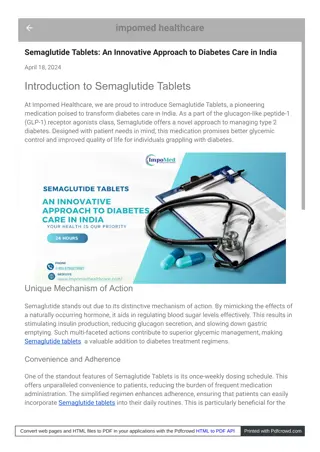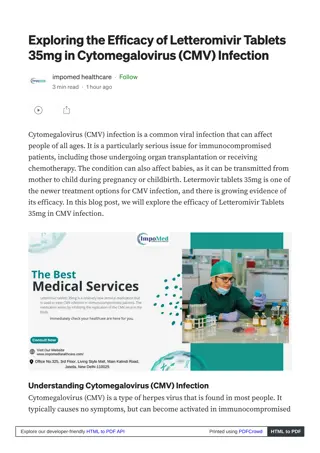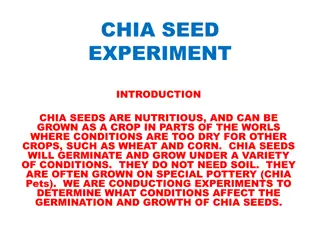Analyzing Ibuprofen Tablets: Experiment, Properties, and Testing
Ibuprofen, a non-steroidal anti-inflammatory drug, is examined through experiment, physiochemical properties, dosage forms, synthesis, and assay testing. Its identification tests include melting point, UV absorption, IR spectrum, and TLC analysis. The assay test method involves weighing and processing tablets to determine ibuprofen content accurately. This comprehensive study provides insights into the characteristics and testing of ibuprofen tablets.
Download Presentation

Please find below an Image/Link to download the presentation.
The content on the website is provided AS IS for your information and personal use only. It may not be sold, licensed, or shared on other websites without obtaining consent from the author.If you encounter any issues during the download, it is possible that the publisher has removed the file from their server.
You are allowed to download the files provided on this website for personal or commercial use, subject to the condition that they are used lawfully. All files are the property of their respective owners.
The content on the website is provided AS IS for your information and personal use only. It may not be sold, licensed, or shared on other websites without obtaining consent from the author.
E N D
Presentation Transcript
EXPERIMENT THREE ASSAY TEST OF IBUPROFEN TABLETS
INTRODUCTION: Ibuprofen is a non-steroidal anti-inflammatory agent, belongs to the aryl alkanoic acid derivatives, mainly used as analgesic and anti- inflammatory drug in rheumatoid arthritis and moderate pain.
PHYSIOCHEMICAL PROPERTIES It is a white crystalline powder. insoluble in water, but freely soluble in organic solvents such as acetone, ether, methanol and chlorinated hydrocarbons. As an acid, it can react with bases such as sodium hydroxide to form the water soluble ibuprofen sodium salt. Its molecular weight equals 206.3 g/mole. melting point is 75 C.
AVAILABLE DOSAGE FORMS: Exists as cream, gel, oral suspension and tablets or capsules.
THE 12 PRINCIPLES OF GREEN CHEMISTRY ARE
IDENTIFICATION TESTS Melting Point 75.0-78.0 By UV Exhibits 2 absorption maxima, at 264 nm and 272 nm. The ratio of the absorbance measured at the maximum at 264 nm to that measured at the shoulder at 258 nm is 1.20 to 1.30. The ratio of the absorbance measured at the maximum at 272 nm to that measured at the shoulder at 258 nm is 1.00 to 1.10. By IR The infra-red absorbance spectrum obtained from the sample should be concordant with spectrum obtained from the standard. By TLC The principal spot in the chromatogram obtained with the test solution is similar in position, color and size to the principal spot in the chromatogram obtained with the reference solution.
ASSAY TEST: Weigh 20 tablets, and then grind them using a mortar and a pestle. From the powder, take equivalent amount containing 0.4 g ibuprofen; dissolve in 20 ml chloroform for 15 minutes. Filter the solution under reduced pressure, and wash the residue with two (5 ml) chloroform. Evaporate the filtrate to dryness under current air (inside the hood). Dissolve the solid residue in 80 ml absolute ethanol (previously neutralised with NaOH). Titrate with 0.1 M NaOH using phenolphthalein as indicator.
WEIGH 20 TABLETS To decrease weight variation & increase accuracy of the assay.
EXTRACTION Sample preparation for Elemental analysis . Solids are usually dissolved in a liquids to be extracted. separate the analyte from interferences. obtain the analyte(s) in a form that can be analyzed.
FILTRATION Filtration is commonly used to separate a material in the solid phase from one in the liquid phase
SUCTION FILTRATION VS GRAVITY FILTRATION Gravity filtration is the method of choice to remove solid impurities from an organic liquid. The impurity can be a drying agent or an undesired side product or leftover reactant. Gravity filtration can be used to collect solid product, although generally vacuum filtration is used for this purpose because it is faster. Vacuum filtration is used primarily to collect a desired solid, for instance, the collection of crystals in a recrystallization procedure. Vacuum filtration uses a Buchner funnel and a side-arm flask. Vacuum filtration is faster than gravity filtration, because the solvent or solution and air is forced through the filter paper by the application of reduced pressure.
SUCTION FILTRATION VS. GRAVITY FILTRATION
FLUTED FILTER PAPER VS. CONE FILTER PAPER The major advantage of a fluted filter is that it increases the speed of filtration for two reasons: first, it increases the surface area of the filter paper through which the solvent seeps; second, it allows air to enter the flask along its sides to permit rapid pressure equalization
A ROTARY EVAPORATOR (OR ROTAVAP) IS A DEVICE USED IN CHEMICAL LABORATORIES FOR THE EFFICIENT AND GENTLE REMOVAL OF SOLVENTS FROM SAMPLES BY EVAPORATION.
ROTARY EVAPORATOR (OR ROTAVAP) Principle Components A motor unit that rotates the evaporation flask or vial containing the user's sample. A vapor duct that is the axis for sample rotation, and is a vacuum-tight conduit for the vapor being drawn off of the sample. A vacuum system, to substantially reduce the pressure within the evaporator system. A heated fluid bath (generally water) to heat the sample. A condenser with either a coil passing coolant, or a "cold finger" into which coolant mixtures such as dry ice and acetone are placed. A condensate-collecting flask at the bottom of the condenser, to catch the distilling solvent after it re-condenses. A mechanical or motorized mechanism to quickly lift the evaporation flask from the heating bath. The principle is that Vacuum evaporators as a class function because lowering the pressure above a bulk liquid lowers the boiling points of the component liquids in it.
CALCULATIONS The chemical equation for the titration step should be:
CALCULATIONS Note: Each 1 ml of 0.1 M NaOH is equivalent to 20.63 mg of Ibuprofen. According to BP, Ibuprofen tablets should contain not less than 95% and not more than 105% of the labelled amount of Ibuprofen. According to USP, Ibuprofen tablets should contain not less than 90% and not more than 110% of the labelled amount of Ibuprofen.
SOURCE OF ERRORS Intrinsic errors (end point # eq. point) Systematic errors (vol. glassware accuracy) Instrumental errors( temp.) Method errors( nonideal chemical behavior) Personal errors (misreading the volume) Gross errors (personal carelessness) Indeterminate or random errors
THINK What could be the difference between the assay of tablets contain ibuprofen from powder of ibuprofen? When ibuprofen can not be given to a patient?























